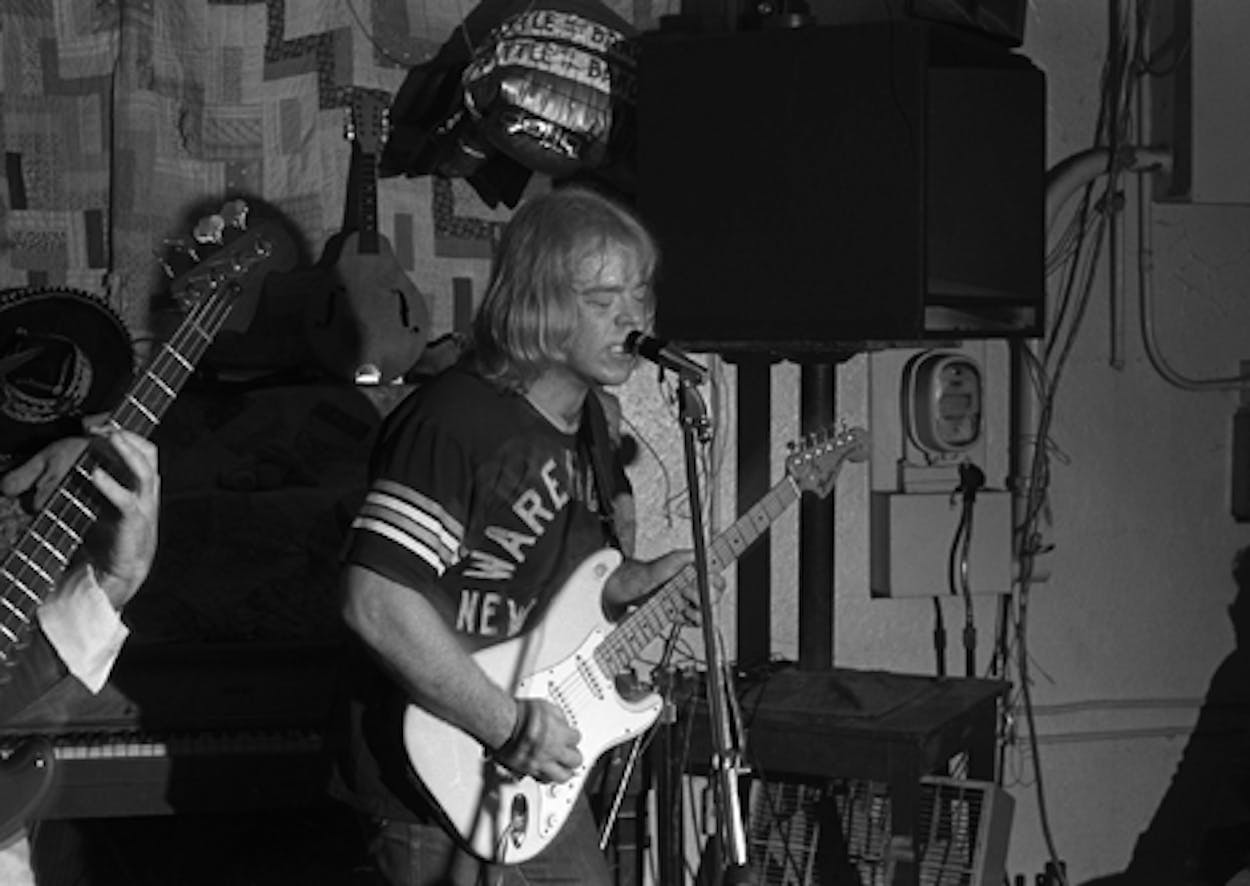In 1979, under the headline “Lone Star Legend,” Rolling Stone profiled Rocky Hill, detailing the Houston guitarist’s career, which was too often derailed by stubbornness and self-sabotage. The piece refers to an unreleased album that the writer guessed might trigger Hill’s transition from a regional guitar hero to a national one.
That transition never happened. Instead, Hill—who died in 2009 at 62—is regularly referred to by a small cult of fanatics as “the best guitarist you never heard.” And the tantalizing album Rolling Stone cited? Recorded in 1977, it finally saw its first release earlier this year.
“Thirty-four years ago, I thought I was going to be a rock mogul, and Rocky would be a rock star. It didn’t quite work out that way,” said John Lomax III of Nashville, who financed and co-produced what he calls the “lost” 1977 sessions. Earlier this year, he released the album on digital media platforms like iTunes and Amazon under the title Texas Guitar Legend, but it has largely gone unnoticed.
The sessions Lomax produced in the late ’70s were meant to be the groundwork for Hill’s first solo record, his springboard to stardom. But with his reputation for erratic offstage behavior and long periods of inactivity, Hill’s career was one extended false start. The 1977 sessions exemplified his problems working within the modern music industry, which stemmed from Hill’s insistence on micromanaging the recording process.
Hill’s career started with promise. In Dallas, at 15, he led his first band, The Starliners, which morphed into American Blues, a psychedelic trio featuring Hill’s younger brother, Dusty, on bass, and the drummer Frank Beard. They served as the backup band for the blues legends Jimmy Reed and Freddie King and recorded two albums before dissolving in 1968.
Dusty Hill and Beard then moved to Houston and joined the guitarist Billy F. Gibbons to form the definitive ZZ Top lineup. Rocky Hill soon followed them to Houston and began an apprenticeship with Lightnin’ Hopkins, a blues legend from the Third Ward.
Hill toured occasionally with a few different bands, which would draw respectable crowds at classic Houston nightclubs like Irene’s, the Old Quarter and Anderson Fair. He eventually took to referring to himself as the anti-Clapton, a dig at Eric Clapton, who Hill said played a bastardized version of blues.
“There’s an entire generation of musicians who went backwards in time through the British scene and realized the source material was right in our backyard,” Gibbons said. “And Rocky thought he’d swum further back upstream than anybody else as a historian and purist. His dedication to cracking the code was serious. In the blues, Rocky would call that searching for ‘the wrong ways to get right.’”
By 1977, Lomax—a third-generation member of the family famous for its field recordings that documented the nearly forgotten history of blues, gospel, and folk music—convinced Hill to record a rock-leaning album. Lomax co-produced the sessions in Garland, and they included songs written by David Olney and Townes Van Zandt.
“Rocky was so well known as a blues guy, I wanted to show he could stand up there with Jeff Beck, Jimmy Page and Clapton,” said Lomax, who recently completed a deal to sell Texas Guitar Legend CDs in Europe early next year.
Lomax’s recordings fell to the wayside when Hill returned to Houston and signed with Bill Ham, who was managing ZZ Top. It wasn’t until 1982 that Hill finally delivered a national release, Texas Shuffle, featuring cameos from high-profile admirers like Dr. John and Johnny Winter. Even so, Hill’s ongoing battles with drugs and alcohol made touring almost impossible. Subsequent solo releases in 1988 and 1994 also failed to ignite his career.
Although the tracks on Texas Guitar Legend had previously only been available as a bootleg, Hill’s fans have long contended that those songs best showcase his innovative guitar skills. It’s evident in the blistering solo on a six-minute version of Van Zandt’s “Waitin’ Around to Die” and in Hill’s interplay with the former Merle Haggard fiddler Jimmy Belkin on the album-opening “A Message to Garcia.”
“He had a peculiar way of bending the strings,” Gibbons said, citing Hill’s linebacker build as the source of an audible physicality he brought to his sound. “The natural way of bending a string is pushing it upwards on the neck. Instead of pushing three or four times and getting a vibrato effect, he would push the note up to the higher note, return back to zero and then pull the string down and it would stretch up to that same note. You have to be stronger than an ox to do it.”
To Lomax, the release of Texas Guitar Legend is all about the notion of legacy, both his own, as part of a family that exposed underrated talents, and Hill’s, as a world-class musician. It’s a prospect that leaves Gibbons genuinely hopeful.
“As much as we miss Rocky, I think everybody who knew him and loved him breathes a little easier that maybe this is the kind of attention he won’t have the opportunity to get into the middle of and turn upside down,” Gibbons said. “People need to know this was a guy that could outplay the best of ’em.”







